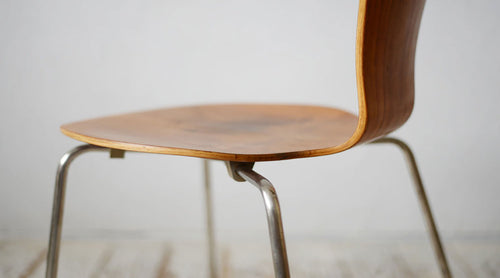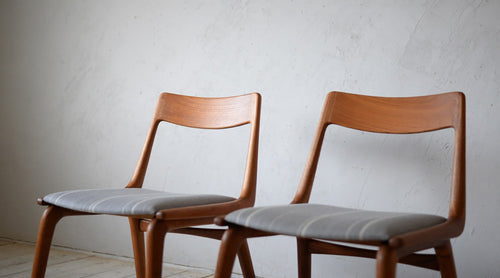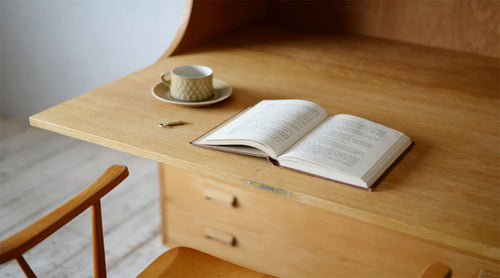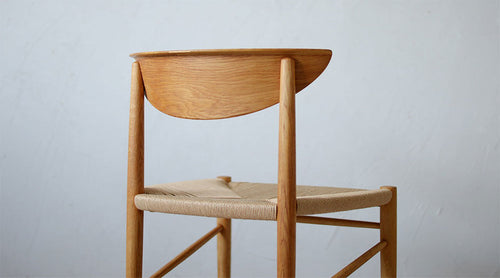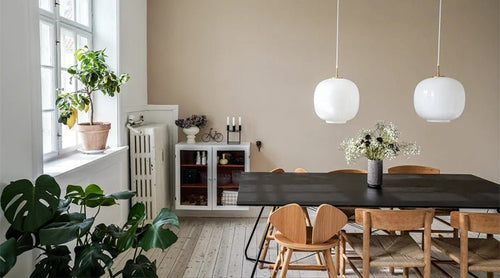- 北欧の暮らしのアイデア
Introducing the characteristics of Danish furniture, representative designers and chairs
Denmark, a Scandinavian country known as a "design powerhouse," is known for its furniture. Behind the creation of these excellent designs lies the culture, environment, and lifestyles and thinking of the people of Denmark, a "rich country," from which we at Greenwich get inspiration for our "Life Places" (places that satisfy the soul).
This time, we will take an in-depth look at the historical background of Danish furniture, which has a strong connection to us, with reference to the book "Understand the Flow! The History of Danish Furniture Design: Why Did So Many Masterpieces Come from Denmark, a Northern European Country?" (by Tadara Keita/Seibundo Shinkosha), which is also on sale at Greenwich.
About Denmark

High tax rates but comprehensive social welfare system
Denmark is widely known as a country with excellent social services. For example, medical care, childbirth, and education are free, and there are also excellent services for the elderly and disabled. In order for the country to provide these generous social services, Danish citizens pay high taxes. Value-added tax, which is equivalent to Japan's consumption tax, is 25% . Income tax, which includes national and local taxes, varies depending on the amount of income and place of residence, but if you have a high income, you will pay about half of your income as tax.
Denmark also has a well-established family doctor system, which has also been promoted in Japan in recent years. If you are not feeling well, you will first be examined by your family doctor, and only if this examination determines that advanced medical care or more detailed testing is necessary will you be treated at a large hospital where advanced medical care can be received. This system prevents waste of tax money, as only necessary patients go to large medical institutions. Consultations with your family doctor are of course free, and there are no charges for advanced treatment at large medical institutions. This well-balanced medical insurance system creates a society where people can live without worry and without wasting tax money.
Consistently ranked among the top in world happiness rankings
Regarding education costs, all public schools from elementary school to university are free. Compulsory education lasts for 10 years from grade 0 to 9 , and students attend a combined elementary and junior high school. Approximately 20% of students attend private schools, but even in private schools, tuition fees are only about 15% of the total, and the rest is covered by taxes. When students turn 18 , they are given a student grant called SU ( Statens Uddannelsesstotte ) by the government for up to six years, with no obligation to repay. If SU alone does not cover the shortfall, they are expected to work part-time, but there is no need to work so much that it interferes with their studies.
In this way, Denmark has created a society where people can live comfortably until retirement by all citizens contributing money together. One example of this is that since 2012 , Denmark has consistently been in the top three in the World Happiness Report published annually by the United Nations (in the latest 2022 ranking, Denmark is 2nd and Japan is 54th ). This shows how Danish people pay high taxes in order to receive comprehensive social services, while also enjoying comprehensive social services.

Danish society is built on a "sense of collaboration"
The foundation of the generous social welfare system described above is the "sense of collaboration" that is unique to the Danish people. Denmark once ruled over most of the Scandinavian Peninsula, but Sweden gained independence in 1523 , and Denmark lost Norway in the turmoil of the Napoleonic Wars in the early 19th century, becoming a small European country. The "sense of collaboration" was the key to designing a society where people could live comfortably, racking their brains to make the most efficient use of limited land, resources, and human resources.
Danish farmers, who once mainly produced wheat and grain, were forced to switch to dairy farming and meat processing following the collapse of crop prices at the end of the 19th century. The concept of cooperatives came into play at that time. Each farmer in a village pooled together the costs to jointly build and share facilities such as milking parlours and meat processing plants, which would have been hugely expensive to build individually. This enabled them to smoothly transition to dairy farming and meat processing. This can be said to be the forerunner of the sharing economy that we hear so much about these days.
The concept of a cooperative later spread to include not only producers but also consumers, and developed into the FDB , a consumer cooperative with member retailers nationwide. FDB Möbler was established in 1942 as the furniture division of FDB (see below).
People spend more time indoors in winter, leading to the development of comfortable living spaces
Denmark is a country about the size of Kyushu in Japan, with a population of about 5.8 million, which is roughly the combined population of Fukuoka and Saga prefectures. Compared to Japan, you can get an idea of how small a country Denmark is. Because it is located much further north than Japan, it has a very comfortable climate and long days in the summer when the weather is good, but in the winter the nights are long and dark. It doesn't snow much, and there are many rainy and cloudy days even in the winter. This climate has also had a big impact on Danish culture. In the summer, it is not uncommon for families to go on picnics after returning home from school or work. Because people spend a lot of time indoors in the winter, comfortable living spaces have developed. It is thought that this is why so many functional and beautiful pieces of furniture have been designed.
Danish furniture enthusiasts

The Danish people are adept at creating comfortable spaces where they can be themselves, and they are particularly particular about their furniture.
When choosing furniture, first analyze yourself thoroughly. Understand the physical and mental needs of your personality. Then, by matching your furniture and interior design to "how you were shaped as a person," you can create an interior space that not only looks good, but also allows you to be yourself, and that you think is truly good. Your personality and how you want to spend your time at home. By deciding on furniture based on "how you want to live" rather than "what you want others to think of you," even if the homes have the same layout, each person's unique, comfortable space can be created to suit them.
Also, for the Danish people, who spend a lot of time at home and therefore spend a lot of time with their furniture, it is very important when choosing furniture that they will not tire of over time and will be able to develop an attachment to for a long time.
How to do self-analysis when selecting furniture, and the key points for choosing furniture that will last for a long time are introduced in detail in the article "Choosing Scandinavian style furniture for a comfortable space."
The history of Danish furniture
The Golden Age (Early 1940s - 1960s )
Kaare Klint: the man who laid the foundations for the Golden Age
 Kaare Klint, an architect and furniture designer, is known as the father of Danish modern furniture design and has had a major influence on later designers. Klint began teaching at the furniture department of the Royal Danish Academy of Fine Arts in 1942, became the department's first professor in 1944, and continued to train the next generation of designers at the Royal Academy of Fine Arts until his death in 1954.
Kaare Klint, an architect and furniture designer, is known as the father of Danish modern furniture design and has had a major influence on later designers. Klint began teaching at the furniture department of the Royal Danish Academy of Fine Arts in 1942, became the department's first professor in 1944, and continued to train the next generation of designers at the Royal Academy of Fine Arts until his death in 1954.
When Klint began teaching, the modernist movement, centered around the German art school Bauhaus, was sweeping Europe. The chairs produced at the Bauhaus, which advocated "rationalism and functionalism based on industrial mass production," were made possible by applying materials and techniques that had not previously been used in furniture production and eliminating unnecessary decoration. In Denmark, this evolved in its own way, embodying the essence of modernism, which is to open design to the general public while maintaining wood and the traditional craftsmanship that comes with it. Klint was the leader of this movement, and he established a design methodology called "redesign," which involves sincerely facing past traditions and redesigning them through research, analysis, and study.
Clint has also studied the correlation between the human body and furniture, and the modules of storage furniture. The golden ratio of 1:1.414 is also used in Japan as an aesthetic ratio. He assigned the numbers derived from it to the dimensions of each part of the human body in inch standards and applied them to furniture design.
In this way, Klint respected past designs and traditional craftsmanship while at the same time adding mathematical approaches and concepts of usability to furniture design, successfully designing functional and beautiful furniture. This design methodology was passed down to Ole Wanscher and Børge Mogensen, who studied furniture design under Klint, and is said to have had a major influence on the formation of the golden age of Danish modern furniture design, becoming the mainstream, so to speak.
The Cabinet Makers Guild Exhibition, one of the factors that led to the Golden Age
The Cabinet Makers Guild is a union of furniture craftsmen. They had their own stores and served as sales outlets for mainly wealthy customers, while at the same time controlling the quality of the products to ensure there was no variation in quality. They also functioned as a place of learning for young craftsmen.
The Cabinet Makers Guild planned an exhibition. The background to this was that after the war, the Danish krone had risen in value, making it easier to import luxury woods such as mahogany. The purpose of the Cabinet Makers Guild exhibition was to produce high-quality furniture using luxury woods and to appeal to consumers the high level of skills that had been handed down for many years.
The exhibition, which began in 1921 and continued for 40 years, including during World War II, from 1927 to 1966, after a brief break. This exhibition is known as a place where many masterpieces were created through collaboration between furniture designers, architects and furniture makers. Famous combinations of furniture designers and furniture makers, such as Kaare Klint and Rudolf Rasmussen, Hans J. Wegner and Johannes Hansen, and Finn Juhl and Niels Vodder, were born at this exhibition.
During the 40 years that the exhibition was held, a total of 78 furniture craftsmen and over 230 furniture designers and architects participated, including many of the leading Danish furniture designers of the time, as mentioned above, making it a highly influential exhibition during Denmark's Golden Age.
FDB Möbler, who popularized high-quality furniture to the general public during the Golden Age

FDB is the abbreviation for the Danish Consumers' Cooperative Union (Danish Consumers' Cooperative Union), which was established in the late 19th century. FDB Möbler was established in 1942 as its furniture division, and was started based on the revolutionary and demanding development criteria at the time: "durable, beautiful, functional, and affordable."
The first head of planning and design was Børge Mogensen, who had been the talk of the town at the Cabinetmakers' Guild exhibition. The content of his exhibition matched the ideal image of a modern home drawn by Frederik Nielsen, who was the chairman of FDB. Mogensen put into practice the design methodology advocated by Kaare Klint and created the "high-quality furniture for the general public" that FDB Møbler aimed for.
Co-operative members could order FDB Möbler furniture from catalogs placed not only in FDB Möbler specialty stores, but also in approximately 2,000 chain stores across Denmark. In this way, FDB Möbler used the overwhelming organizational power of the co-operative to establish "quality furniture for the general public" among the Danish people. FDB Möbler, which supported and raised the standard of living of the Danish people through furniture, is an indispensable presence in the discussion of the golden age of Danish furniture.
*For more information about FDB Møbler, please see "Why FDB Møbler is loved in Scandinavia."
Denparmanente contributed to sales during the company's golden age
Denparmanente was started in 1931 by Kai Booysen, an ironworks craftsman and designer, in collaboration with Christian Grauballe, director of Holmegaard, a long-established glass manufacturer. It is a permanent exhibition center that collects high-quality Danish everyday items, and was opened on the second floor of the Vesterport Building, located near Copenhagen Central Station and renowned for its modern exterior at the time. The background to this is that in the 1920s, various everyday items were imported from overseas. Kai Booysen, who felt a sense of crisis that traditional high-quality everyday items such as Royal Copenhagen and Holmegaard were being pushed aside, started the center with the aim of "making Danish people recognize the appeal of their own country's products once again" and "effectively promoting the high quality of Danish products to overseas buyers."
The opening of Den Parmanente attracted public interest at the time, with approximately 100,000 visitors in the first year after opening, and by 1937 the annual number of visitors had reached 195,000. After that, the museum was in danger of closing due to a lack of operating funds caused by the war, but it was able to recover by making major changes to the members of its management committee. The new management committee, realizing the importance of public relations overseas, actively promoted the museum overseas, and this bore fruit as tourists from overseas flocked to Den Parmanente. In the 10 years from 1950, sales increased more than five-fold, and the museum made a remarkable comeback.
Although the national demand of the small country of Denmark was limited, the excellent Danish crafts and everyday items were introduced to the world through d'Empermanente, making a big impact. At the same time, the furniture presented at the Cabinet Makers' Guild Exhibition, which was also very popular, also took flight to the world through d'Empermanente.
Decline (early 1970s to 1980s )
Danish modern furniture design enjoyed its golden age from the 1940s through to the 1960s , but its popularity began to wane in the 1970s and it entered a long period of decline.
The first factor was that after the Golden Age, demand for Danish modern furniture from overseas, especially in the United States, suddenly increased. Most furniture workshops at that time were made up of around 20 to 30 furniture craftsmen. As such small workshops, they were busy dealing with the influx of orders from both within and outside of Denmark, and no longer had the capacity to collaborate with furniture designers and architects to develop new pieces. It is also thought that there was a sense of complacency due to the fact that the popular furniture produced during the Golden Age sold like hotcakes.
The second reason is the aging of furniture craftsmen. In the Golden Age, furniture making flourished through collaboration between designers and furniture craftsmen, but with post-war modernization, furniture making in Denmark also changed from small-scale production in furniture workshops to mass production in large-scale factories also known as furniture factories. Denmark used to have many furniture craftsmen with advanced woodworking skills, but with the changing times, their numbers have steadily decreased. Many furniture workshops were forced to close down as they were unable to train successors.
Thirdly , the famous furniture designers and architects who were active during the Golden Age are now old and have passed away one after another, which is also a factor in the decline of the style. Arne Jacobsen, Ole Wanscher, Finn Juhl, Børge Mogensen and Poul Kjaerholm all passed away in the 1970s and 1980s .
present day
 Although it went into decline in the 1980s , Danish modern furniture design did not completely fall into disuse. It began to be gradually reevaluated in Japan from the mid -1990s , and in the 2000s , it began to be frequently introduced in the media under the banner of "Scandinavian design." This can be seen as a result of the growing interest in products that are essentially excellent, even if they are not flashy, rather than self-evaluating superficial products, after the bursting of the bubble economy.
Although it went into decline in the 1980s , Danish modern furniture design did not completely fall into disuse. It began to be gradually reevaluated in Japan from the mid -1990s , and in the 2000s , it began to be frequently introduced in the media under the banner of "Scandinavian design." This can be seen as a result of the growing interest in products that are essentially excellent, even if they are not flashy, rather than self-evaluating superficial products, after the bursting of the bubble economy.
Since then, "Scandinavian design" has been established as a genre of interior design. Danish furniture in particular has been widely featured in interior and fashion magazines as the core of "Scandinavian design."
Around 2000 , new brands such as HAY and muuto were established, which comprehensively produce not only furniture but also lighting fixtures and household goods, and have breathed new life into Danish design in recent years. In addition, a new generation of designers such as Kasper Salto and Cecilie Manz are also active.
The charm of Danish furniture

The appeal of Danish furniture is that its design was created under the concept of "better life." The underlying theme of all Danish design was the mission of the designer to provide the people with better everyday items and ensure that their lives are enriched, and that this enrichment is essential. The concept of "design" originally encompasses all kinds of activities, large and small, carried out to improve life and society. Denmark was the society in which "design" in its original sense was widely established. The furniture designers representing Denmark did not simply aim to design good furniture, but tried to create a better life by designing good furniture. Denmark has many unique designers and architects, but it can be said that many pieces of furniture that have been loved by consumers for a long time were born because of this common awareness at the root. The comfortable lifestyle unique to Denmark, such as "hygge," was realized thanks in part to the efforts of these designers.
Characteristics of Danish furniture

・The outstanding sensibility of the designer and the outstanding skill of the craftsman who creates it are always brought together in one piece of work. Whether it is a one-of-a-kind handmade piece of furniture or mass-produced furniture, this basic attitude remains the same. The power to design and the power to create are mutually horizontal, which enhances the capabilities of each.
・Behind each piece, you can sense the boundless " empathy " with the people who will use it. This " empathy " is empathy with the everyday lives of ordinary people, and with humanity itself. The furniture is designed to the utmost extent to understand the nature of the object, to the point where it will share a person's life with them as they use it, become familiar with it, and spend the years with it.
- A unique understanding and sensibility towards materials that is necessary for making things. A deep understanding of materials that comes from people who have faced nature in harsh climates, looked at nature, and looked inside themselves. Danish furniture is not just about accepting the quality and characteristics of the material, but is characterized by an attitude of deeply understanding the quality of the material, and then challenging itself through design and production techniques to see how much human skill and technology can make the most of the material.
Based on the above three points, the characteristics of Danish furniture can be summarized into the following six points.
(1) Excellent craftsmanship
(2) A thorough and in-depth understanding of the material
(3) Proposals for improving human life
(4) Understanding and expressing beauty
(5) Respect for the individuality of designers
(6) Commitment to Quality
Danish furniture designers /chairs
Kaare Klint
...the father of Danish modern furniture design

Born in Copenhagen, Denmark in 1888. Known as the "father of modern Danish furniture," he has influenced many designers across generations as a designer, professor, and leader in the design world. His ideas of "ergonomics" and "redesign" are highly regarded for their major reform of the traditional methods of architecture and furniture design that had placed emphasis on style. Representative work: Church Chair
Borge Mogensen
...an idealist for the common man's life

Born in Aalborg, Denmark in 1914. Studied under Kaare Klint at the furniture department of the School of Design, the predecessor of the Royal Danish Academy of Fine Arts. He continued to learn design from Klint as an assistant. In 1942 , at the age of 28 , he became the first representative of FDB Möbler . He continued to pursue the simplification of furniture design structure and the craftsmanship that requires human hands for the details. Representative works: J39, Spanish Chair
Hans J. Wegner
...the pinnacle of craftsmanship

Born in Tønder, Denmark in 1914 , he entered the world of design as a cabinet maker's apprentice at the age of 14. He qualified as a joiner at the age of 17 , and then furthered his specialist research into wood at the National Industrial Institute. At the age of 22 ( 1936 ), he began studying design at the Copenhagen School of Arts and Crafts. After graduating in 1940 , he was in charge of designing furniture for Aarhus City Hall in a collaborative project with Arne Jacobsen. He went independent in 1943 and has since designed over 500 chairs, winning numerous awards at exhibitions both in Japan and abroad. Notable works: The chair , CH24
Arne Jacobsen
...a versatile perfectionist

Born in Copenhagen, Denmark in 1902. Graduated from the Royal Danish Academy of Fine Arts in 1927 , he worked as an architect in Copenhagen for two years before setting up his own design firm. World-famous as a modernist in Danish architecture, his works range from grandiose buildings such as the National Bank of Denmark to small items such as wall clocks and cutlery. Representative works: Seven Chair , Swan Chair
Finn Juhl
...A unique aesthetic sense

Born in Copenhagen, Denmark in 1912. Known for his beautiful designs, he is known as the "furniture sculptor." The Niels Votter workshop played a major role in his work, and he was one of the designers active during the period when designers and workshops worked closely together. Many of his pieces are made from Brazilian rosewood and high-quality teak, which are now difficult to obtain. Representative works: Pelican Chair, No. 45 , Chieftain Chair
Peter Hvidt & Orla Mølgaard Nielsen
...Hidden masterpiece "AX Chair"

Peter Hvidt was born in 1916 and Orla Molgaard Nielsen in 1907 in Copenhagen, Denmark. Both architects, they opened a joint design office and worked in the fields of furniture, decoration and architecture. Representative works: Portex chair, AX chair
Grete Jalk
...Female designer who edited the magazine "mobilia"

Grete Jalk was born in Copenhagen, Denmark in 1920. She was one of the few female designers active during the Scandinavian Golden Age. After training as a furniture maker, she studied under Kaare Klint at the Royal Academy of Fine Arts and went independent in 1953. She has written not only about furniture design, but also about the history of design, and has edited the Cabinetmakers Guild exhibitions over the past 40 years. Her most famous work: GJ Chair
Arne Vodder
...studied under Finn Juhl

Born in Denmark in 1926. After gaining experience in architecture and furniture manufacturing under Niels Vodder , he studied under Finn Juhl at the Royal Academy in Copenhagen. Since then, Finn Juhl has been his mentor, friend and business partner. After graduating, he worked as a designer in charge of office decorations in Hindsgaul , Copenhagen, and in 1950 he established an architecture and design studio with architect Anton Borg . In addition to furniture, he has also designed 1,100 low-cost houses, achieving great success. Notable work: side board model29A
Kai Kristiansen
...Practicing what Clint taught me

Born in Denmark in 1929. He was a co-organizer of the Scandinavian Furniture Fair from 1966 to 1970. In Japan, some of his products have been reproduced by Miyazaki Chair Factory since 2014. Representative works: NO.42 , NV31, FM Reolsystem Wall Unit
Conclusion
What do you think about the characteristics of Danish furniture from the perspective of the country's characteristics and history? What kind of environment and culture are behind the excellent design? What kind of history has it followed? By unravelling this in detail, the appeal of the design will become even deeper.
If you would like to know more about Danish furniture, we recommend that you also read Tadara's book mentioned at the beginning , "Understand the Flow! The History of Danish Furniture Design: Why So Many Masterpieces Were Born in Denmark, a Northern European Country" (Seibundo Shinkosha) .
We hope that this will be an opportunity for you to discover the deeper appeal of Danish furniture, which goes beyond its appearance.
Public Relations: Okada

About
この記事をかいた人
岡田 智理
グリニッチ広報・企画担当。
インテリアコーディネーター資格、住空間収納プランナー資格を所有。
ブログや企画イベントを通して、暮らしを満たすヒントや、グリニッチが提案するさまざまな価値について、明るく楽しくお伝えしていきます。

